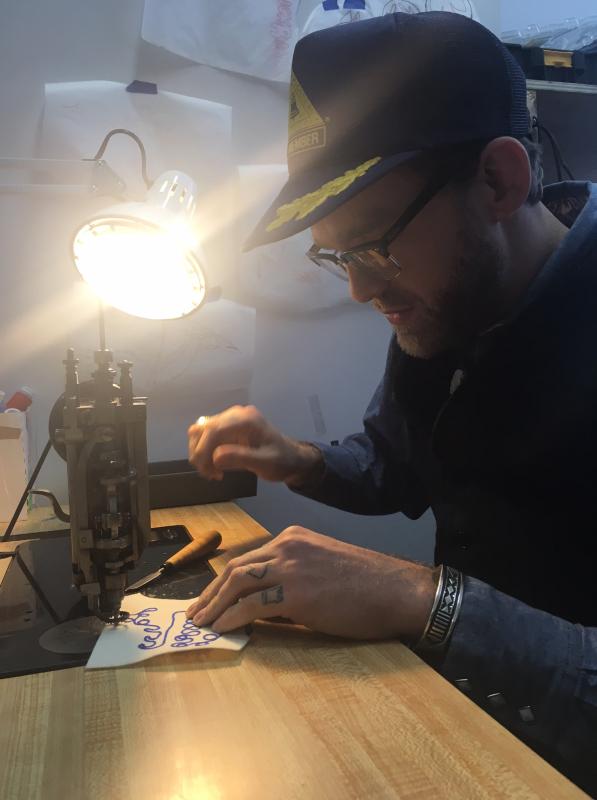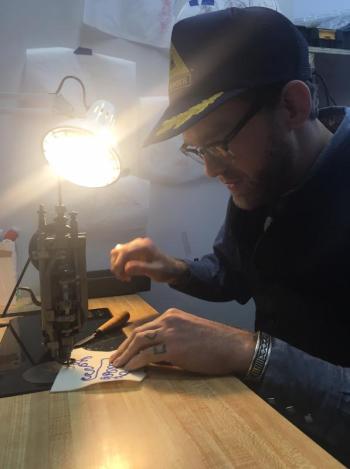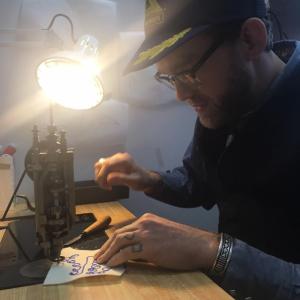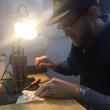Entrepreneur develops business niche in Rockland with antique sewing machines, chainstitch embroidery
 Griffen Cooper at work in his studio. (Photo by Jenna Lookner)
Griffen Cooper at work in his studio. (Photo by Jenna Lookner)
 Griffen Cooper at work in his studio. (Photo by Jenna Lookner)
Griffen Cooper at work in his studio. (Photo by Jenna Lookner)
ROCKLAND — Entering Griffen Cooper’s studio at the Lincoln Street Center for the Arts is an immediate feast for the senses. Early industrial sewing machines of various design and repair are set up throughout the snug but well-appointed space, designs and embroidered patches adorn the walls, and a rolling rack filled with vintage clothing suggests projects in the wings. A chalkboard on the wall leftover from the building’s previous iteration as a public school contains scrolled notes and ideas.
Like his vintage sewing machines themselves, Cooper’s passion — and now his business — the Chainstitch Repair Company, has been humming along since he became interested in pursuing the art of chainstitch repair in 2016.
Cooper, 26, of Rockport graduated from Camden Hills Regional High School in 2009. His travels, including several lengthy motorcycle trips, took him to destinations including Austin, Texas, where he encountered chainstitch embroidery while bartending an event at Willie Nelson’s ranch. The company Fort Lonesome was set up as a vendor at the event, doing embroidery work for musicians, he explained.
“Fort Lonesome is a completely female-owned company which is really cool,” he said, “it was really my first exposure to [chain stitch].”
“Fast forward a year,” he continued, “and I had moved back to Camden and was looking on Craigslist for a place to live. I found a studio space for $200 a month, I didn’t know what I was going to do, but I rented it.”
The space acted as the catalyst for buying his first 1930s vintage Singer sewing machine, a 114w103 model, which he purchased on eBay.
“It was missing parts,” he said with a chuckle, admitting that his inexperience had played a factor in buying the incomplete machine. It didn’t take long for Cooper to discover that the parts he needed weren’t available at the hardware store.
“I had to find the parts and that lead on a really thrilling rabbit chase,” he said.
The “rabbit chase” allowed him to discover the community of chainstitch enthusiasts, and to connect with others who shared his burgeoning — and obscure — passion.
“I learned to repair my machine before I learned how to use it, and it opened my eyes to a huge secondary market,” he said.
He added that there are approximately 30 brands that do chainstitch presently, and that the need for parts is “growing really quickly.”
The parts for the Singer machines he favors are not only a challenge to find, but they’re proprietary in their manufacture. Each part is stamped and produced to fit in a way that is, “just slightly off standard,” he said. Additionally, Singer never published repair manuals for their early machines. Cooper explained that this was a tool to have repair jobs sent directly to the company.
At one point Cooper had amassed eight Singer embroidery machines, and currently has five working machines, some of them perform different functions. He also typically has at least one machine in his shop from a client for repair. One of the things that intrigues him about industrial sewing machines is that they are made to “do one thing extraorinarily well.”
Though his collection includes machines that perform various functions, among them a heavy-duty, long arm Singer designed for use on leather, a machine he said is his oldest and dates to about 1900, he gravitates toward two in particular.
“I use an embroidery machine and a zig-zag machine on a daily basis,” he said, gesturing at the two.
Cooper is essentially self-taught and jokes that after sorting out the requisite repairs for his first machine that “a lot of really crappy practicing ensued.”
“Once the machine was running, I learned the types of thread, the capabilities of the machine and what fabrics to use,” he said.
His interest in the art of chainstitch extends beyond the machines, and even beyond the art itself. Cooper has become a historian, as well.
He explained that he can identify where machines were made based on letter stamps that proceed the serial numbers assigned to indicate various Singer production factories across the country, additionally he can typically tell which machines were used in factories. All parts made by Singer were stamped “SIMANCO” as an abbreviated version of the company’s full name. Cooper has adopted CHARECO as the abbreviation for Chainstitch Repair Company.
While his collection primarily consists of Singer machines, he owns and works on imported pieces, as well. Presently, he’s repairing a German manufactured machine for the owner of a thrift store in Boston.
Cooper said he often has to buy parts from India in bulk, and is not always satisfied with the quality. Thus he has teamed up with a metal fabricator and machinist to alter parts to fit various machines entrusted to him. Additionally, the finish work brings the imported parts up to his standard of quality.
“These machines often have different designs, but the same mechanical functions,” he explained in reference to working on unfamiliar marques.
Cooper explained that he considers himself a “commercial artist as opposed to a fine artist” and gravitates toward the personal projects that he finds inspiring.
“I do a lot of naturalist designs,” he explained, pointing at a stack of embroidered patches hand drawn and stitched by him.
His capabilities include embroidered upholstery and soft goods for the home as well, and he uses different threads and fabrics to accommodate each project’s needs. He explained that a soft cotton thread is typically what he uses when working on a garment to achieve the most tactile result. When a project involves a cushion (boat or home) or an object that will see more wear, he switches to a more durable, higher sheen acrylic thread.
Cooper remarked that the lion’s share of the embroidered linens in the hospitality industry were done with chainstitch.
“For about 100 years this was how all embroidery was done,” he added.
While most of his work is direct to garment, he hopes to expand in the coming year.
Cooper explained that most of the chainstitch machines extant in the USA are in the Midwest or the Los Angeles area. The art of chainstitch last realized popularity in 1970s Los Angeles, he said.
Perhaps the most notable application of chainstitch was the ever popular “Nudie Suit,” designed by the Ukrainian-born American tailor Nudie Cohn.
“Think of the rhinestone cowboy suits,” Cooper said. He added that Jerry Garcia, Graham Parsons and Porter Wagner were among the “iconic American musicians” that wore chainstitch-embroidered Nudie Suits.
“The Nudie Suit was the most recognizable American application of chainstitch from the 1940s until the 1970s,” he explained, using an iPad to flip through photos of some of the most recognizable musicians of the 1960s and 1970s clad in their intricately embroidered Nudie Suits.
One aspect of the craft that Cooper enjoys most is the connection between maker and garment that is achieved with chainstitch. He explained that in the 1950s it might have taken as many as 10 machines to produce a pair of Levi’s jeans in a factory due to the specificity of each machine. That connection has been relegated as tools of production have become more efficient and technologically evolved.
“[Chainstitch was popular] back when manufacturers had a direct relationship to what they were making,” he said.
He explained that there is also a difference in the style of detail one can achieve with a chainstitch machine versus a modern, computer operated machine. Cooper likened the aesthetic to the precision of a computer-operated CNC mill versus a hand-operated mill for wood or metalwork. The latter being comparable to chainstitch, where direct human touch informs the manufacture and result of each unique piece.
Cooper’s process involves drawing a pattern prior to executing the embroidery. He said that he never had an interest in pursuing drawing prior to his pursuit of chainstitch, however he has been inspired to take up drawing as a vehicle to creating his own patterns. Once the pattern is drawn and traced onto a transfer fabric, the embroidery of a small patch takes him about an hour. He does not use a printer or computer in designing or creating his pieces.
“My market is people who want something handmade and unique that is relatable to Americana,” Cooper said.
He said he has discovered that chainstitch is complementary to many different crafts. There are hundreds of hobbyists, he estimates, but he is not aware of anyone else who is doing chainstitch in the region. Cooper has developed relationships with industrial repair shops in various parts of the state that refer antique sewing machines in need of repair directly to him.
“They know I love these machines, and they don’t really work on them,” he said.
To date, Cooper has done some retail with local businesses, including the Rockland-based vintage goods shop, Curator, where he has sold work in the past. Still, he said, he does his marketing almost exclusively through Instagram.
Cooper said that although he hasn’t made marketing his priority, he garners tremendous fulfillment from the work he does.
“It gave me a purpose. I don’t have to be doing anything, but when I’m here, I’m happy.” he said of being in his studio.
Cooper said he also loves teaching others his craft, and even has his two embroidery machines — both obtained from a home in Massachusetts and traced back to the same Bridgeport, Connecticut, Singer factory — set up across from one another to create an ideal space for instruction. In addition to repairs and embroidery work, Cooper has found intrigue in the thrill of the chase created by the ever increasing demand for parts. He also said he embraces “any excuse to buy more tools.”
“In some cases if I had been just five minutes later I would have missed out,” he said of finding obscure and interesting machines and parts.
Learning through trial and a lot of error, Cooper has become a skilled craftsman, repairman and collector. He would also perform appraisals if asked, he said.
“I get so much personal enrichment and enjoyment out of just tuning these things,” he said of his machines, “it feels really great to have such a unique skillset.”
While he likened many of his commissions to creating denim jacket murals and said he feels like he is tattooing clothing, he also helps out with the occasional utilitarian, practical repair. As the interview concluded, a friend stopped by with a glove in need of some TLC. He had made an appointment with Cooper to fix up his ailing glove.
Cooper quickly set to work on the piece, approaching the repair with the same care and fascination as he does his art: melding new with antique, keeping his machines relevant, demonstrating his previous statement about the versatility of these lovely, simple old pieces and their functionality in the modern era.
To learn more about the Chainstitch Repair Company visit them on Instagram, check out their Etsy store, or email chainstitchrepaircompany@gmail.com.
Jenna Lookner can be reached at jlooknercopy@gmail.com
Event Date
Address
United States



























